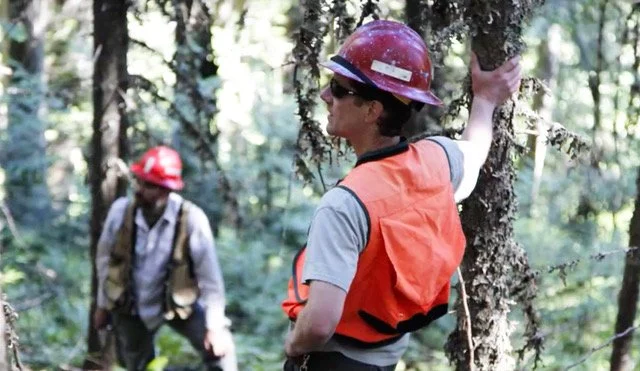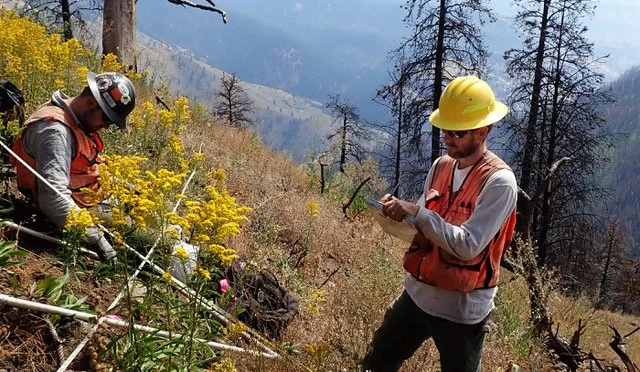In the Nez Perce-Clearwater National Forest, Dr. Andy Hudak relaxes with a crew inventorying and coring trees for age. - Photo credit - Luigi Boschetti
Wildfire Ecologist Swaps Hard Hat for Office Attire
by Will Simpson
Moscow, Idaho. It was a cold, rainy February morning to be riding a bicycle. On his way to his office, Dr. Andy Hudak stopped for a hot cup of drip coffee at One World Café on Main Street. Last week he was in Florida studying prescribed forest fires. In two weeks, he will travel to Georgia to study their methods of prescribed burning.
“Climate change is such an overreaching issue for everything we do. It’s hard to think of something we do that doesn’t have at least some implication for climate change,” said Hudak.
Hudak’s current research uses aerial Light Detection And Ranging (LiDAR) to study how wildfires interact with the forest. LiDAR is a 3D imaging system consisting of a laser and an echo recorder. An airplane or drone carries the LiDAR systems flying over a study area, recording the echoes of each laser shot. Automated algorithms then filter and interpolate the data onto a Digital Terrain Model to represent the ground and a Canopy Height Model to represent vegetation. Other 3D models are converted into maps that reveal pre-fire, active fire, and post-fire ecological conditions. It turns out this technology has other uses.
Hudak grew up in rural Minnesota near Grand Rapids. He has loved to explore his surroundings from a young age and discovered his interest in the world’s ecological wonderlands. He was interested in ecology before he even knew what the word meant.
Steeped in a culture where his dad was an avid hunter and fisherman had a lot to do with how he grew up, eventually leading Hudak to a career as a Research Forester.
“Ideas and things I could observe just being out in the woods is all part of ecology, so I got interested in that,” Hudak said.
His formal education started at Itasca Community College in Grand Rapids, Minnesota. Hudak later transferred to the University of Minnesota at St. Paul. He graduated with a Bachelor of Science degree in Ecology, Evolution, and Behavior.
In his last year at the University of Minnesota, his application to graduate school at the University of Colorado and his application to join the Peace Corps came through at the same time. Now he needed to decide between continuing schooling or traveling the world.
Hudak decided to join the Peace Corps and taught secondary science in Malawi, Africa. They needed someone with a science degree. “I was curious about teaching and teaching is one thing you can do with a science degree,” said Hudak.
While in Africa, he became interested in the issues around local deforestation. Africa has been struggling to fight deforestation. Hudak questioned what he could do to study this problem and find a way to contribute to a solution.
Hudak likes works with Ph.D. students from the University of Idaho from his office at the USFS Rocky Mountain Research Station on the east side of the University of Idaho campus. His primary research interest is in fire ecology. Still, sometimes he gets called on to share his expertise with researchers in other fields. Hudak used his expertise in remote sensing to coach Jessica Stitt, a Ph.D. candidate in Wildlife Biology.
Together with Lee Vierling, Professor of Natural Sources, University of Idaho, Kerri Vierling, Professor of Wildlife Resources, University of Idaho, and Carlos Silva, Assistant Professor of Quantitative Forest Science, University of Florida, Hudak worked with Stitt to develop a research paper called “Evaluating the Use of Lidar to Discern Snag Characteristics Important for Wildlife,” published February 2022, in Multidisciplinary Digital Publishing Institute’s Remote Sensing Journal.
A dead tree still standing in the forest are known as snags. Snags are essential for wildlife. Raptors use large snags as nesting platforms, and woodpeckers use the smaller snags as nesting sites. A tree becomes a snag when it dies naturally of old age or gets killed in a forest fire. “People should understand that fire is not evil and shouldn’t be vilified,” said Stitt.
Stitt’s research paper used Airborne Laser Scanning to map and identify where and how big the snags were. Her study plots were in forest stands within the Idaho Panhandle National Forest.
Hudak is an active birder with a passion for bird ecology. This was not the first time his expertise in remote sensing got him involved in studying the ecology of snags.
Hudak spends a lot of time considering the impact of his research, working with students and coauthors as a team to write research papers. He is always ready for new challenges.
Dr. Andy Hudak and Ryan McCarley inventorying residual fuels in 2019, a year after the 2018 Rattlesnake Creek Fire, near Riggins Idaho. Photo credit - Benjamin Bright
“I still have trouble saying no to learning new things,” said Hudak. He has the freedom to choose the topics he studies. Hudak works on whatever piques his interest and gets to choose his collaborators, which is why he loves his work so much.
“One of the draws for a lot of the people that do this kind of work is to be able to be in field and in the woods. When you’re out in the field, you remember, ‘OK this is why I’m doing it.’ Once you are sitting behind a computer, it gets harder and harder to remember ‘Why am I analyzing this data?’” said Stitt. Fieldwork gives the freedom of being untethered to email and cell service. Being in the forest is challenging work. The rewards come from being in the forest.
The attention his research has attracted has pushed Hudak out of the field and into the office, and he’s find himself more often swapped the hard hat and work boots for comfortable office attire. “I have less time to do my own analysis now. I do a lot more project management, so I’m in a lot more meetings, I’m often running the meetings.”
As the morning rain passed and the sun poked through the clouds. Hudak swigged the last of his coffee donned his bicycle helmet, pant leg clips, and rain jacket. Then pedaled off towards another project management day at the office.
References
Stitt, Jessica M., Andrew T. Hudak, Carlos A. Silva, Lee A. Vierling, and Kerri T. Vierling. 2022. “Evaluating the Use of Lidar to Discern Snag Characteristics Important for Wildlife.” Remote Sensing 14 (3): 720. https://doi.org/10.3390/rs14030720.




